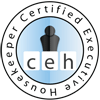Rinsing is the act of “removing the soil loosened or dissolved in the cleaning process,” says Don Aslett, author of The Cleaning Encyclopedia: Your A to Z Illustrated Guide to Cleaning Like the Pros. It’s most often associated with clean water, but rinsing can involve any solution, such as mild acids used to neutralize alkaline detergents and soaps.
“Failure to rinse well will leave a streaky dull finish on hard floors, a sticky film on carpet or upholstery that attracts new dirt quickly, and detergent residues on clothes that can cause allergies,” says Aslett. If left on floors, this residue leaves streaks or haze when dry, and it will likely have an adverse effect on the longevity of any floor wax or polish applied on top of it.
Plain water won’t completely neutralize the alkalinity of most cleaning agents and detergents where one cannot use large amounts of water, such as in floor and counter cleaning or on any porous surface. The haze and streaks will come out, however, if you add a small amount of plain white vinegar to rinse water.









